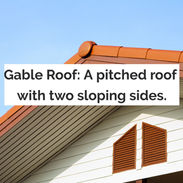Home/ Roof Design/ Shapes/ Types
Related: Commercial Roof/ Residential Roof/ Resources/ About Us
There is a wide variety of roof designs, shapes, and types used in architecture and construction around the world. While it's challenging to provide an exact number due to the countless variations and regional differences, a list of some of the most common types include:
-
Gable Roof (COMMON)
-
Hip Roof (COMMON)
-
Gambrel Roof
-
Mansard Roof
-
Flat Roof (COMMON)
-
Shed Roof
-
Butterfly Roof
-
Saltbox Roof
-
Dutch Gable Roof
-
Jerkinhead Roof (Half-hipped Roof)
-
Skillion Roof
-
Dome Roof
-
Pyramid Roof
-
Sawtooth Roof
-
Curved Roof
-
Bonnet Roof
-
Combination Roof
-
A-frame Roof
-
Butterfly Roof
-
Cradle Roof
-
Bell-cast Roof
-
Clerestory Roof
-
Round Roof
-
Saddleback Roof
-
L-Shaped Roof
-
T-Shaped Roof
These are just some examples, and there are many more variations and combinations. Additionally, within each type, there can be further variations in terms of pitch, material, and architectural details.

Here's a breakdown of the pros and cons of some common roof types:
-
Gable Roof:
-
Pros: Simple design, good water drainage, provides attic space, allows for ventilation, cost-effective.
-
Cons: Prone to wind damage in certain configurations, may require additional bracing in high wind areas.
-
-
Hip Roof:
-
Pros: Excellent stability against wind and snow loads, all sides slope, good drainage, provides extra living space in the attic.
-
Cons: More complex to build than gable roofs, may be more expensive due to additional materials and labor.
-
-
Flat Roof:
-
Pros: Economical, modern aesthetic, can be used as a living space or for installing solar panels, easy to access for maintenance.
-
Cons: Limited drainage, prone to leaks if not properly installed and maintained, may require additional structural support.
-
-
Mansard Roof:
-
Pros: Provides extra living space in the attic, stylish and traditional appearance, allows for flexibility in adding windows.
-
Cons: Complex design may be more expensive to build, requires regular maintenance, may not be suitable for areas with heavy snow loads.
-
-
Gambrel Roof:
-
Pros: Provides extra space in the attic, classic barn-like appearance, good drainage.
-
Cons: Vulnerable to high winds, may require additional structural support, not as common in modern construction.
-
-
Shed Roof:
-
Pros: Simple design, easy to build, good for modern and minimalist aesthetics, allows for easy rainwater collection.
-
Cons: Limited attic space, may require additional waterproofing measures, may not suit traditional architectural styles.
-
-
Dome Roof:
-
Pros: Unique and eye-catching design, offers structural strength, provides spacious interior, good for large public buildings.
-
Cons: Expensive and complex to build, limited design flexibility, may be challenging to integrate with other architectural elements.
-
-
Pyramid Roof:
-
Pros: Excellent stability against wind and snow loads, provides a visually striking appearance, good for small structures or as a feature on larger buildings.
-
Cons: Limited attic space, may be more expensive to build due to complex framing, may require additional waterproofing measures at the apex.
-
These are just some general pros and cons, and the suitability of each roof type depends on various factors such as climate, budget, architectural style, and personal preferences.

Metal Roof
A metal roof is a roofing system made from metal panels characterized by its high resistance, impermeability and longevity. A metal roof panel is made of materials such as zinc, copper and steel alloys.





